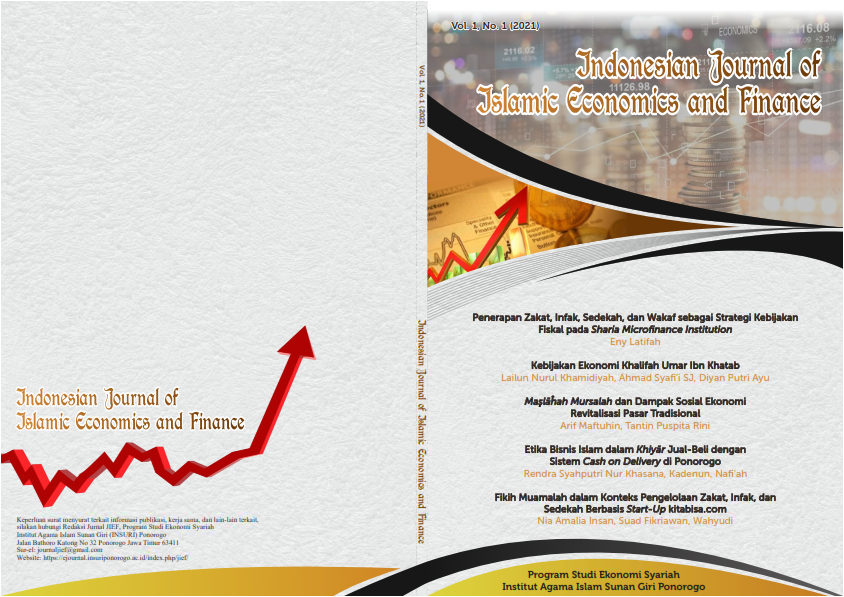Determinants of Islamic Commercial Bank Performance in Indonesia
DOI:
https://doi.org/10.37680/ijief.v3i2.6131Keywords:
Islamic Commercial Banks, Islamic Bank Performance, Return on Assets Islamic commercial banksAbstract
As financial intermediary institutions, banks have a strategic role in driving the economy, so bank performance must be appropriately maintained. This study aims to analyze the effect of third-party funds and working capital financing of Islamic commercial banks on the performance of Islamic commercial banks in Indonesia. The research method used is quantitative by conducting multiple linear regression tests. The data type used is secondary data from 2015 to 2022, with a sample of 13 Islamic commercial banks in Indonesia. The data was obtained from BI and OJK reports published on https//www.ojk.go.id. The study results indicate that Third Party Funds do not affect Indonesia's ROA of Islamic commercial banks. Working capital financing significantly affects the ROA of Islamic commercial banks in Indonesia. And if together, third-party funds and working capital financing significantly affect the ROA of Islamic commercial banks in Indonesia. Third-party funds do not affect the ROA of Islamic general banks because the operational costs (BOPO) borne by Islamic general banks are included in the very high category. Therefore, to increase ROA, banks must apply the principle of prudence and valid calculations in carrying out banking operations and financing.
Downloads
References
Astutiningsih, K. W., & Baskara, I. G. K. (2019). Pengaruh CAR, Dana Pihak Ketiga, Ukuran Bank, dan LDR terhadap profitabilitas Bank Perkreditan Rakyat [PhD Thesis]. Udayana University.
Fadhila, N. (2015). Analisis Pembiayaan Mudharabah Dan Murabahah Terhadap Laba Bank Syariah Mandiri. Jurnal Riset Akuntansi Dan Bisnis, 15(1).
Gani, I. M., & Bahari, Z. (2021). Islamic Banking's Contribution to the Malaysian Real Economy. ISRA International Journal of Islamic Finance, 13(1), 6–25.
Hakim, I. A. (2020). Analisis Faktor-Faktor Yang Mempengaruhi Minat Pengusaha Usaha Mikro, Kecil dan Menengah (UMKM) Mengajukan Pembiayaan di Bank Syariah Kota Malang. Jurnal Ilmiah Mahasiswa FEB, 9(2).
Hamdani, H., Wahyuni, N., Amin, A., & Sulfitra, S. (2018). Analisis Faktor-Faktor yang mempengaruhi Kinerja Keuangan Bank Umum Syariah yang terdaftar di Bursa Efek Indonesia (BEI)(Periode 2014-2016). Jurnal Emt Kita, 2(2), 62–73.
Ilyas, R. (2019). Analisis Kelayakan Pembiayaan Bank Syariah. Asy Syar’iyyah: Jurnal Ilmu Syari’ah Dan Perbankan Islam, 4(2), 124–146.
Jatmiko, U., & Agustin, B. H. (2018). Analisis Financing To Deposit Ratio Dan Dana Pihak Ketiga Terhadap Return on Asset Pada Pt. Bank Rakyat Indonesia Syariah. An-Nisbah: Jurnal Ekonomi Syariah, 4(2), 99–126.
Kuncoro, H. F. T., Anam, S., & Sanusi, M. (2020). Analisis pengaruh dana pihak ketiga dan non performing financing terhadap return on asset pada BPRS di Indonesia. Jurnal Manajemen Dan Bisnis Indonesia, 6(1), 88–94.
Levine, R. (1997). Financial Development and Economic Growth: Views and Agenda. Journal of Economic Literature, 35(2).
Litriani, E. (2017). Pengaruh Pembiayaan Modal Kerja Terhadap Pendapatan Usaha Nasabah Pada PT. Bank Syariah Mandiri Kantor Cabang Simpang Patal Palembang. I-Finance: A Research Journal on Islamic Finance, 3(2), 123–140.
Otoritas Jasa Keuangan. (2014). Peraturan Otoritas Jasa Keuangan Nomor 8/POJK.03/2014 tentang Penilaian Tingkat Kesehatan Bank Umum Syariah dan Unit Usaha Syariah. OJK.
Rahayu, A. S., Indrawan, A., & Sudarma, A. (2021). Pengaruh Pertumbuhan Dana Pihak Ketiga (DPK) Dan Capital Adequacy Ratio Terhadap Return on Asset. Balance : Jurnal Akuntansi Dan Bisnis, 6(2), 122.
Respati, A. R. (2023). Pangsa Pasar Perbankan Syariah Masih Kecil, OJK Bangun Ekosistem dan Dorong Konsolidasi. Kompas.Com.
Risal, T. (2019). Peningkatan peran perbankan syariah dengan menggerakkan sektor riil dalam pembangunan. Accumulated Journal (Accounting and Management Research Edition), 1(1), 36–47.
Rizal, F. (2022). Analysis of the Robustness of Islamic Commercial Banks in Indonesia during the Covid-19 Pandemic. Journal of Islamic Economics and Finance Studies, 3(1), 12–23.
Rizal, F., & Humaidi, M. (2021). Analisis Tingkat Kesehatan Bank Syariah di Indonesia 2015-2020. Etihad: Journal of Islamic Banking and Finance, 1(1), 12–22.
Rizal, F., & Rofiqo, A. (2020). Determinants of Sharia Banking Profitability: Empirical Studies in Indonesia 2011-2020. El Barka: Journal of Islamic Economics and Business, 3(1), 137–161.
Sebayang, R. (2023). 2023, BI Targetkan Industri Syariah Capai Market Share 20%. CNBC Indonesia.
SEBI No.13/24/DPNP tentang Penilaian Kesehatan Bank Umum. (2011).
Statistik Perbankan Syariah. (2023). Otoritas Jasa Keuangan.
Sugiono. (2010). Metode Penelitian Kuantitatif, Kualitatif dan R & D. Alfabeta.
Suretno, S., & Bustam, B. (2020). Peran Bank Syariah dalam Meningkatkan Perekonomian Nasional Melalui Pembiayaan Modal Kerja pada UMKM. Ad-Deenar: Jurnal Ekonomi Dan Bisnis Islam, 4(01), 1–19.
Taslim, S. A. (2021). Pengaruh Pembiayaan Bagi Hasil terhadap Tingkat Profitabilitas Bank Umum Syariah di Indonesia. Jurnal Akuntansi Indonesia, 10(1), 97–109.
Thoyyibah, R. R., & Fitri, L. E. (2024). Pengaruh Dana Pihak Ketiga, Pembiayaan, dan Non Performing Financing Terhadap Return On Assets Bank Jambi Syariah. Bertuah Jurnal Syariah Dan Ekonomi Islam, 5(3), 338–349.
Downloads
Published
How to Cite
Issue
Section
License
Copyright:
An author who publishes in Indonesian Journal of Islamic Ekonomics and Finance agrees to the following terms:
- Author retains the copyright and grants the journal the right of first publication of the work simultaneously licensed under a Creative Commons Attribution-NonCommercial 4.0 International License that allows others to share the work with an acknowledgment of the work's authorship and initial publication in this journal.
- Author is able to enter into separate, additional contractual arrangements for the non-exclusive distribution of the journal's published version of the work (e.g., post it to an institutional repository or publish it in a book) with the acknowledgment of its initial publication in this journal.
- Author is permitted and encouraged to post his/her work online (e.g., in institutional repositories or on their website) prior to and during the submission process, as it can lead to productive exchanges, as well as earlier and greater citation of the published work (See The Effect of Open Access).
License:
-
Attribution — You must give appropriate credit, provide a link to the license, and indicate if changes were made. You may do so in any reasonable manner, but not in any way that suggests the licensor endorses you or your use.
-
NonCommercial — You may not use the material for commercial purposes.
-
No additional restrictions — You may not apply legal terms or technological measures that legally restrict others from doing anything the license permits.
You are free to:
- Share — copy and redistribute the material in any medium or format
- Adapt — remix, transform, and build upon the material

This work is licensed under a Creative Commons Attribution-NonCommercial 4.0 International License.



.png)







